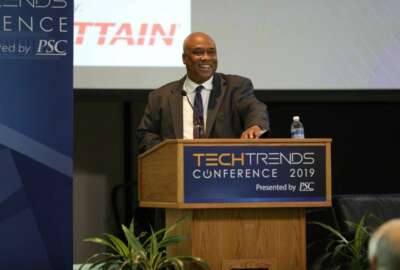

The Office of Federal Procurement Policy released three memos since October to give agencies guidance on buying from AbilityOne firms, emphasizing skills over e...
When it came to federal acquisition policy, the four years of the Trump administration could be considered a time of Laissez-faire.
There were only four acquisition memos signed off by the director of the Office of Management and Budget that didn’t deal with the COVID-19 pandemic in the past 48 months. Sure acquisition was part of many, if not all, of the technology memos and the data strategy memos, but those that addressed federal procurement and only federal procurement, were few and far between.
Along with those four OMB memos, the Office of Federal Procurement Policy issued five other memos, including three in the last month, which directed agencies to take specific steps to improve federal procurement.
In all, that’s nine memos in four years or 2.33 memos a year, which equals not a lot of oversight or changes to the federal acquisition process from a governmentwide and OMB level.
Now that doesn’t mean the federal acquisition process has been stagnant for four years. We all recognize there has been plenty of change, with the continued rise of other transaction agreements, the successes during the pandemic and the continued push for innovative approaches like reverse industry days and the use of robotics process automation to reduce manual or tedious processes.
This is why it’s significant that in his waning days as administrator, Michael Wooten, who joined in August 2019 as OFPP administrator, signed out three memos, including one to further drive one of his key initiatives — reducing acquisition timelines.

“This memorandum takes an important step toward measuring the timeliness of federal procurements by establishing a common definition of ‘procurement administrative lead time (PALT)’ and providing guidance on steps agencies should take to reduce PALT in their acquisition activities through modern business practices that shorten the time from the identification of need to delivery of value,” Wooten wrote in the Jan. 11 memo. “By measuring PALT and addressing areas of friction, the federal government will continue to build on prior actions to more effectively steward the use of American taxpayer dollars.”
Along with the PALT memo, Wooten signed out another one on Jan. 7 to reinforce the idea that they should limit how they require educational certifications and licenses instead of just accepting stated skills when buying IT services and other types of services.
“Focusing on desired competencies to achieve stated outcomes, rather than imposing degree requirements, helps to break down barriers to entry and promote effective competition by giving prospective government contractors the flexibility they need to build a team with the best suited personnel to address an agency’s requirements. This flexibility is especially important for those small businesses that may otherwise lack the resources to participate in competitions for services if their existing employees do not meet the educational requirements and deprive taxpayers of the resourcefulness and ingenuity that these small businesses could bring to the federal marketplace,” Wooten wrote. “In addition, by avoiding reflexive use of educational requirements, agencies can also realize significant savings and cost avoidance while still getting access to the critical skills they need.”
Wooten issued a third memo on Oct. 30 reminding agencies to take steps to increase the participation of people with disabilities in federal contracting, specifically by awarding more contracts to companies under the AbilityOne program. The memo states agencies spent about $4 billion with AbilityOne contractors in fiscal 2019.
While two of these memos are just good reminders, addressing the timeliness of acquisitions has been a priority for Wooten.
“I think [PALT] is a powerful management tool that we should use to examine our performance, to examine the performance of our systems and look for ways to improve the systems. It is not a bludgeoning tool to be use to whip the workforce to get product out faster,” Wooten said at the National Contract Management Association Government Contract Management Symposium in December. “We need to look at this as a measurement of the system and the effectiveness of the system.”
The memo finalized the definition of PALT — “[T]he time between the date on which an initial solicitation for a contract or order is issued by a federal department or agency and the date of the award of the contract or order” — and provides guidance to promote consistent application across agencies.
Wooten said the definition and use of PALT is a good first step toward improving the acquisition process.
“There is a lot of important work that goes on before you even start the PALT clock. We must not ignore that,” he said. “There are some agencies who already are measuring that and should continue to measure that. The whole point of frictionless acquisition is reducing the time between identifying a need and saying I’ve now received those goods and services.”
As a part of the frictionless acquisition cross-agency goal under the President’s Management Agenda, OFPP says in its fiscal 2020 fourth quarter update that the next step after releasing the definition is to capture and baseline data to create a common benchmark to improve agency processes.
OFPP set a goal for agencies to complete 90% of routine, non-major acquisitions and 80% of complex major acquisitions within a timeframe comparable to private sector averages or benchmarks of leading state and local governments or federal agencies by 2025.
“PALT can help to drive continual process improvement and the pursuit of more innovative procurement practices, especially when the data are used in combination with other inputs for evaluating the overall effectiveness of the acquisition process in delivering value to the taxpayer, such as cost and the quality of the contractor’s performance,” the memo stated. “As agencies evaluate PALT, they should consider the growing list of proven business practices and technologies that agency acquisition innovation advocates (AIAs) and industry liaisons have been promoting to reduce friction across the acquisition lifecycle. This includes using more innovative and less burdensome processes for conducting acquisitions, leveraging technology to modernize operations and help the workforce move from low to high value activities, and taking advantage of modern ‘high definition’ data analytics to support smarter buying decisions.”
Wooten’s memo includes a four-phase approach to reduce PALT as well as 17 agency examples of strategies to reduce lead time.
Of course, the PALT varies depends on what agencies are buying.
Soraya Correa, the chief procurement officer at the Department of Homeland Security, said she believes the clock starts when a program office says “I think I have a need” and the contracting team starts engaging with the program office.
“The other step in this is how we do our market research. Is market research merely going online and seeing what contractor did this before or is it, maybe, going out to industry with this problem statement and say, ‘Tell us about this. How do you do this? How do you evaluate this?’ All too often we are hesitant to go talk to industry and a lot of times they have good answers, and by the way, if they have input into that solicitation, I think it helps us,” she said. “I think it helps us do a better solicitation and possibly helps us when we get to the debriefing and that all-dreaded protest phase because we would’ve had good industry input and hopefully we will learn from it. So when I think about PALT, I think about moving that dynamic to the left.”
This acceleration doesn’t mean a lack of rigor either. Wooten and others say the goal of PALT, under the Frictionless Acquisition initiative, is all about removing the tedious processes that have become barnacles to the procurement process.
Copyright © 2024 Federal News Network. All rights reserved. This website is not intended for users located within the European Economic Area.
Jason Miller is executive editor of Federal News Network and directs news coverage on the people, policy and programs of the federal government.
Follow @jmillerWFED



